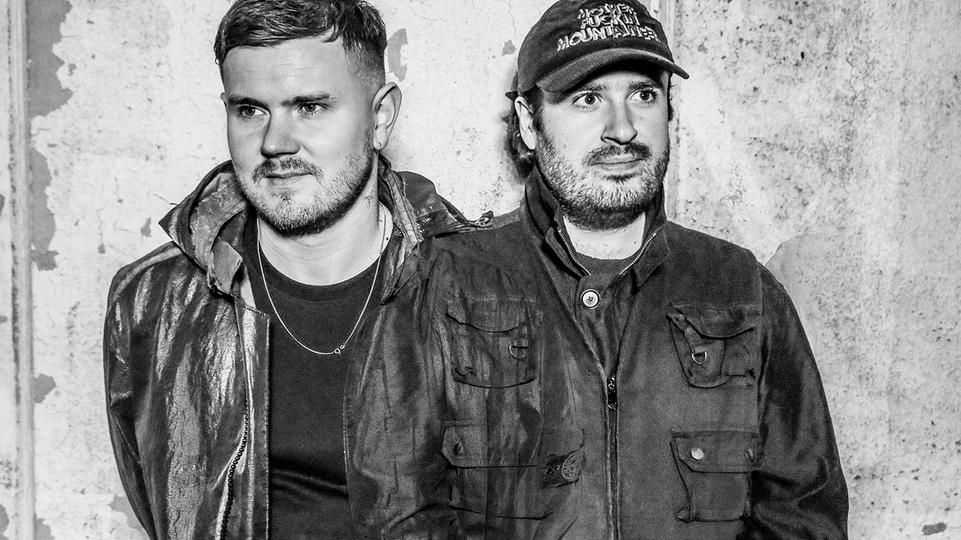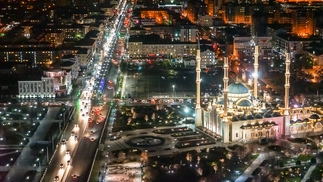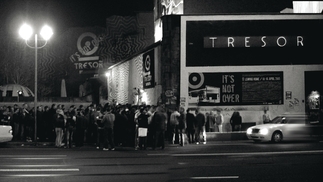Clouds are the hardcore visionaries creating a nightmare future with techno

Scottish hardcore visionaries Clouds, together with designer David Rudnick, have gone above and beyond for their new album project, creating a nightmare future, yet finding their own peace within it...
Words: BEN HINDLE
Pics: GEMMA PARKER
It’s past midnight and DJ Mag is roaming around the grounds of a former prison in the arse-end of Amsterdam. We’re here with Clouds, a young Scottish duo who, over the past half-decade, have scorched their name into the techno scene through a combination of uniquely detailed productions and blunt force trauma DJ sets.
The pair were originally supposed to perform at the Bijlmerbajes prison complex and, although the gig was sadly cancelled, we’ve made the journey anyway in order to get some suitably dystopian shots for this piece. Unfortunately, as with seemingly everywhere in Amsterdam, the developers got here first, and finding a gritty backdrop is proving nigh-on impossible — goddamn gentrification. There’s also been another complication; the boys have brought along a banner roughly 10-foot high by 20-foot wide, and finding somewhere to hang it has seen Liam Robertson and Calum Macleod drag around building equipment and scale a shipping container and the walls of a basketball court.
Why go to all this trouble? Well, the banner is the final piece of a project almost two years in the making — an exquisitely printed section of the gnarly, bit-crushed artwork that accompanies their new album ‘Heavy The Eclipse’ for Speedy J’s Electric Deluxe label. To call it mere artwork, however, and even to say it’s just an album, is to do a disservice to Clouds and their collaborator, graphic designer David Rudnick. What the trio have created is a world, a hellish vision of a future reality twisted beyond repair, and yet not so far as to become unrecognisable.
DARK VISIONS
To borrow directly from the project’s dedicated website (a slow-scrolling story, presented in 8-bit text that feels like it could be the beginning of a lost DOOM game): “After numerous waves of social collapse, Glasgow, a once prosperous city, had run to waste in lawless ruin. The city passed into the hands of a German-speaking conglomerate, who incorporated the territory into a new civic entity: Neurealm.” The corporation built a rail network — Caledonia New Realm — in an attempt to revive Glasgow. However, after a drug called klaw was introduced to the community, all hell broke loose, and the city devolved into three gang factions who now use the train lines to murder, pillage and wreak havoc on each other and their surroundings. There’s the Dark Leviathan Krew (‘junkie scum’ who loot the city to provide for their habit), the Onslaught Ash Krew (a brutal paramilitary force dedicated to killing addicts), and the Cold Eye Krew (a cult of evacuated citizens who have turned to paganism and blood sacrifice). In this rotten world, the only joy comes in the form of massive multi-day raves, and the only hope is the rumour of, “an avenging angel, a Joan of Arc, a rave goddess” named Eclipser, who lives beneath the city and is destined to bring an end to the horror.
It’s an incredibly in-depth plot that we can’t really do justice to in our quick summary here (read the full script at neurealm.net), supported by several meticulously crafted images and a full rail map. It’s outlandish and exciting, but also terrifyingly relatable in a world where armed troops can storm the dancefloor at Bassiani club, governments and businesses can come out unscathed from tragedies such as Grenfell, the media can whip the public into a frenzy, and ecological disaster is just around the corner. Most of all though, ‘Heavy The Eclipse’ is a hugely impressive feat in a time of disposable music, when the long-player release format is questioned on a regular basis.
“It’s creating a world for people to get into,” explains Calum when we chat after our banner-hanging excursion. “It’s not something you see often in techno, these days at least. Maybe part of the reason, with things being so fast with social media, [is that] stuff isn’t around that long for people to really get into it.”
But this project feels impossible not to get into. The artwork, for instance, is strewn with all sorts of graffiti and gang tags with which to let your imagination run wild, while the story itself is just begging to be turned into a film or graphic novel series. “What I think is important is everything on [the artwork] has meaning,” Calum continues. “Because with a lot of artwork you see with records, and in general graphic design, it’s aesthetically pleasing, but it’s just kind of meaningless. It’s sick looking, but why is it like that? So everything on there has a connection to the world.”
SONIC CHAOS
These tiny yet essential elements reflect a collection of music that is raw, chaotic and ruthless. Opener ‘Neurealm «After The Fall»’ sounds like an all-out laser-sword massacre, ‘Nachtstorm Hardcore’ lives up to its name through a maelstrom of piercing noise and clunky beats, and ‘Skulcoast’ erupts from tense ambience into a savage assault of guerilla breakcore. There are more traditionally dancefloor-friendly moments too, in the intense grooves of ‘Clubber’s Guide To Wreaking Havoc’, the rudeboy percussion of ‘Eclipser’ and the harcore epic ‘Parkzicht’, the album’s only single. There’s even a tribute to an obscure local hero from their time “PC DJing” (basically throwing loads of acapellas over Eurodance or happy hardcore tracks) while growing up in Perth, when their now near-symbiotic production relationship evolved.
At no point could ‘Heavy The Eclipse’ be deemed an easy listen, yet it’s an album that demands to be listened to, and is certainly a rewarding experience, made all the more impressive by the fact that the music itself was completed in just two weeks at Speedy J’s studio — a fact Liam believes led to the album’s cohesive energy and mood.
“We recorded a lot on Jochem’s [Speedy J] instruments,” he says. “Obviously the set-up in there is amazing, and he’s got so many different synths. Really expensive, mad geeky ones. A lot of stuff we processed through modular stuff, especially this module called Clouds,” recalls Calum, chuckling at the unintentional link. “But everything was put together in Ableton, that’s how we’ve always done stuff. I think that’s where a lot of the detail and chaos comes from.”
He explains that they tend not to over-edit or tidy up their samples, leaving the ends rough to add to the hectic atmosphere. “I think we sometimes try hard to make it sound worse, by leaving the little bits in,” smiles Liam. “Like normally you’d think, ‘Oh that doesn’t sound right, I’ll get rid of that’.” Calum cuts in: “If something doesn’t sound right, it’s usually a good thing”.
UNCONVENTIONAL
It’s a far cry from their early, rowdy-but-clean records on Tiga’s Turbo imprint; more in line with the snarling techno they’ve put out through Opal Tapes and Electric Deluxe in recent years, but even set apart from that. This is the result of two factors: firstly, using the length of the album format to create something more conceptual, but also a move to playing only their own tunes when DJing as Clouds. This has allowed them to experiment more, as they don’t need to worry about fitting tracks in among traditional techno.
“Before, we would be like, ‘OK, I need this to fit in someone else’s DJ set’, but now we’re not bothered, like I know how to play that, so I’ll make the tune like I want ’cause I know what I’m gonna do,” Liam says.
“And ’cause we’re playing our own stuff, that’s informing what we do in the studio now more than ever. We’re still writing some kind of big room functional techno shit, but it hopefully has a kind of edge to it that the other big room functional techno shit doesn’t,” laughs Calum. “Obviously that stuff’s fun to play, it’s fun to make, but most of it’s very soulless and shallow. It’s fine most of the time, but when it does have that kind of edge that takes you back, that kind of attitude about it, it’s obviously a lot more effective.”
Even prior to this transition, Clouds found it difficult to fit inside the techno world. Starting their careers as producers way before they learned to DJ caused the pair to avoid normal structures, while a penchant for never taking themselves too seriously — which has resulted in some hilarious track titles, alongside playing everything from happy hardcore to gabber to edits of Russian pop duo t.A.T.u. during sets — Calum believes has potentially hampered their careers.
“If we don’t take ourselves seriously, why should other people take us seriously?” Liam concurs. They aren’t malicious towards the techno crowd, however. The boys simply believe you should have fun in the club. “I think to go out and go dancing on a Friday night or Saturday, you’re meant to be losing yourself in the music, I don’t know why you have to be so negative about other people,” Liam continues. “The fun’s sucked out of it by you being so exclusive.”
“I think it’s like elitism more than anything, like you can’t play this or that,” Calum says, who earlier told us how one major techno brand explicitly warned the duo never to play hardcore again at one of their events, or risk not being booked in the future. “I think we’ve always played stuff that’s maybe a bit more euphoric than the average techno set. I think it’s a bit different now ’cause people are playing some trance and hard trance, but I think people are so afraid of writing something euphoric in case it’s considered cheesy, that they will completely avoid it and suck all the life out of it.”
Only playing their own tunes has had a knock-on effect too, in that, outside of the new album, the pair are producing tracks with the sole purpose of DJing. “I think [we’ve been] taking more risks and just doing what [we] want to do rather than just writing stuff and just settling like, ‘Oh, it didn’t quite hit what I wanted to but it’ll do’,” Calum says. “We’re not thinking like, ‘Let’s write a bunch of tracks for a release’. We’ll just go home and think, ‘I wanna write something to play this weekend, maybe I’ll just play it once’, and it’s very spontaneous. It’s a lot more of a relaxed way to write music.
“That’s the good thing about the album, with Jochem, with Electric Deluxe as well,” Calum continues, “he’s really, really sound about us doing, not whatever we want, but he knows we’re not gonna do something stupid.”
“Like when we got loads of delays and stuff he was like, ‘We’ve gotta do it right’,” Liam says. “We could have cut back on some of the materials and stuff and done it a bit on the cheaper side, and he was like ‘Nah, if we’re gonna do it, we have to do it well’.”
“Yeah, he’s a really wicked person to work with, we’re so lucky. I think that’s another part of why I’m really happy with what we’re doing now; working with Electric Deluxe, working with Jochem, it’s a nice feeling going into the future — hopefully the record does well and it’s not like, ‘That’s the last record we’re doing with you guys’,” Calum laughs.
In the end, DJ Mag does get to catch Clouds in action, going back-to-back with Randomer as Headstrong, the name of the label they run collectively. It’s a set of jackhammer kicks and huge euphoric hardcore synths — what some might call ‘cheesy’, but undeniably fun, and the ravers here in Amsterdam certainly don’t seem to mind. Clouds may make music that’s more boundary-pushing than ever, but they are more comfortable, and whether that means creating nightmarish realms or simply seeing how hard they can bang it out in a club, it can only be a good thing.

Shock Of The Neu: Artist David Rudnick on working with Clouds
“Liam and Calum’s music is not nostalgic and it’s not pastiche, and I wanted to find a way to come up with a [visual] language that had the energy and intensity of the things that we love and inspired us, but didn’t feel like it was referential to them.
“The idea of a rail identity, that and the airport are like the classic graphic design modernist benchmarks, but the idea of building something like that so we could show it in this state of decay — this highly regimented, really ordered top-down view of the city on the map, and then this insane 4-D collapse of having the graffiti and the gangs penetrate into it — that was so visually exciting to me that it set off this chain reaction of doing all this work. But similarly, I don’t come from a graffiti culture. It was out of respect for graffiti that I was like, we have to come up with our own visual language completely from the get-go.
“The thing that allowed that to happen was the development of this kind of unifying hard bitmap pixel style which just drew everything together, in that it allowed me to get pretty freeform with the explorations and still feel like everything was gonna look really Neurealm. I have to say it was one of the most liberating, exploratory graphic experiences I’ve ever had. The graphics took a year-and-a-half to put together, because I just couldn’t stop exploring this world and fleshing it out. I just wanted to give it that richness and depth — that it felt like every surface was erupting in bacteria and moss and rust and covered in this patina of grime and excitement, ’cause it was all there in the music, they gave me such a rich document to work with.
“I can’t stress it enough, I’m a huge fan of Liam and Calum and I think they’re massively underrated as artists. They’re intensely prolific and deeply creative, and I think extremely original. They make some of the hardest, most interesting music that I know, certainly that I think anyone’s making today. But there’s a scope behind it, and the power of their imagination is extraordinary.”





